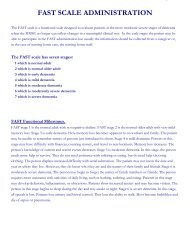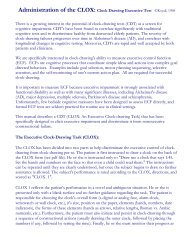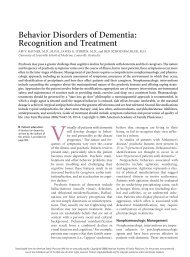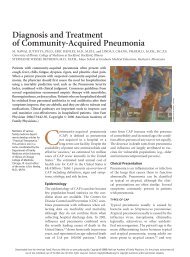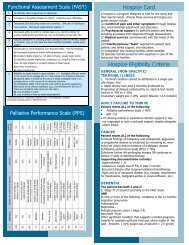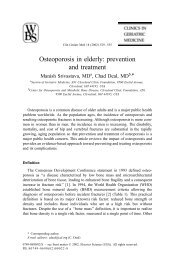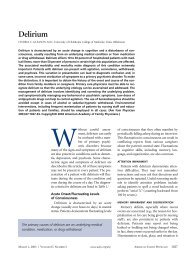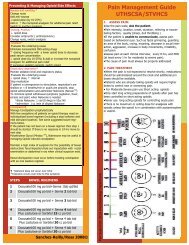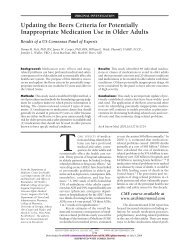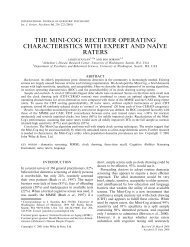Diagnosis and Treatment of Osteoporosis
Diagnosis and Treatment of Osteoporosis
Diagnosis and Treatment of Osteoporosis
Create successful ePaper yourself
Turn your PDF publications into a flip-book with our unique Google optimized e-Paper software.
SORT: KEY RECOMMENDATIONS FOR PRACTICE<br />
Clinical recommendation<br />
Evidence<br />
rating<br />
References<br />
Prevention <strong>of</strong> fractures <strong>and</strong> treatment <strong>of</strong> osteoporosis<br />
Older persons at risk <strong>of</strong> falls should consider exercise, physical therapy, home hazard<br />
B 26, 27<br />
assessment, <strong>and</strong> withdrawal <strong>of</strong> psychotropic medication to decrease fall risk.<br />
Daily vitamin D supplementation (at least 700 to 800 IU), with or without calcium, should be B 15, 31<br />
used to decrease fracture risk in persons 60 years <strong>and</strong> older.<br />
Bisphosphonates should be used to prevent osteoporotic fractures (see Table 5 for specific A 14, 16, 17, 21, 33, 34<br />
indications).<br />
Raloxifene (Evista) can be used to prevent vertebral fractures in postmenopausal women with A 22, 33, 34<br />
osteoporosis, especially if at high risk <strong>of</strong> breast cancer.<br />
Calcitonin (Miacalcin) can be used to prevent recurrent vertebral fractures in postmenopausal B 23, 34<br />
women.<br />
Teriparatide (Forteo) can be used to prevent vertebral <strong>and</strong> nonvertebral fractures in<br />
A 24, 34<br />
postmenopausal women with prior vertebral fractures.<br />
Screening<br />
The following populations should be screened for osteoporosis:<br />
All women 65 years <strong>and</strong> older A 2, 3<br />
Selected postmenopausal women <strong>and</strong> men 50 to 69 years <strong>of</strong> age with risk factors for fracture C 2, 13<br />
All men 70 years <strong>and</strong> older C 2, 13<br />
A = consistent, good-quality patient-oriented evidence; B = inconsistent or limited-quality patient-oriented evidence; C = consensus, diseaseoriented<br />
evidence, usual practice, expert opinion, or case series. For information about the SORT evidence rating system, go to http://www.aafp.<br />
org/afpsort.<br />
Force (USPSTF) guideline, based on a systematic review<br />
<strong>of</strong> the evidence, recommends screening DEXA in all<br />
women 65 years <strong>and</strong> older, as well as in women 60 to<br />
64 years <strong>of</strong> age who have increased fracture risk. The<br />
USPSTF states that the evidence is insufficient to recommend<br />
for or against screening in postmenopausal<br />
women younger than 60 years. 3 The National <strong>Osteoporosis</strong><br />
Foundation (NOF), which receives substantial<br />
support from the pharmaceutical industry, developed<br />
a guideline using an expert panel that recommends<br />
screening in women 65 years <strong>and</strong> older, men 70 years<br />
<strong>and</strong> older, adults with a fracture, <strong>and</strong> selected postmenopausal<br />
women <strong>and</strong> men with clinical risk factors<br />
for fracture (Table 1 2,3 ). 2<br />
Table 1. Selected Factors Associated with Fracture or<br />
Low Bone Mineral Density in Postmenopausal Women<br />
Increasing age<br />
Low body weight (< 127 lb [58 kg])<br />
Personal history <strong>of</strong> fracture<br />
Family history <strong>of</strong> osteoporotic<br />
fracture<br />
Not using hormone therapy<br />
White or Asian race<br />
Information from references 2 <strong>and</strong> 3.<br />
Excessive alcohol (> 2 drinks per day),<br />
caffeine, <strong>and</strong> tobacco use<br />
History <strong>of</strong> falls<br />
Low level <strong>of</strong> physical activity<br />
Low calcium or vitamin D intake<br />
Use <strong>of</strong> certain medications or presence<br />
<strong>of</strong> certain medical conditions (Table 2)<br />
It is reasonable to clinically assess age <strong>and</strong> risk factors<br />
when deciding which women to screen. Validated<br />
clinical rules, such as the Simple Calculated <strong>Osteoporosis</strong><br />
Risk Estimation (SCORE) tool, may be considered<br />
as well. The SCORE tool is a six-item instrument<br />
with a sensitivity <strong>of</strong> 91 percent <strong>and</strong> a specificity <strong>of</strong> 40<br />
percent. It is used to predict which women may benefit<br />
from DEXA screening. 8 This calculator may be found at<br />
http://osteoed.org/tools.php.<br />
The USPSTF found that, for women 55 to 59 years<br />
<strong>of</strong> age, the number needed to screen (NNS) over five<br />
years was more than 4,000 to prevent one hip fracture<br />
<strong>and</strong> 1,300 to prevent one vertebral fracture. The NNS<br />
to prevent one hip fracture over five years declines with<br />
age, to 1,856 for women 60 to 64 years <strong>of</strong><br />
age, 731 for women 65 to 69 years <strong>of</strong> age,<br />
<strong>and</strong> 143 for women 75 to 79 years <strong>of</strong> age. 9<br />
<strong>Diagnosis</strong><br />
<strong>Osteoporosis</strong> is diagnosed clinically or<br />
radiographically. <strong>Osteoporosis</strong> may present<br />
with low-impact fractures (occurring<br />
from a fall at or below st<strong>and</strong>ing height) or<br />
fragility fractures (occurring spontaneously).<br />
7 <strong>Osteoporosis</strong> is most commonly<br />
diagnosed with a T-score <strong>of</strong> −2.5 or below<br />
as determined by central DEXA scan <strong>of</strong> the<br />
total hip, femoral neck, or lumbar spine. 2,3,6<br />
Quantitative computed tomography can be<br />
194 American Family Physician www.aafp.org/afp Volume 79, Number 3 ◆ February 1, 2009



